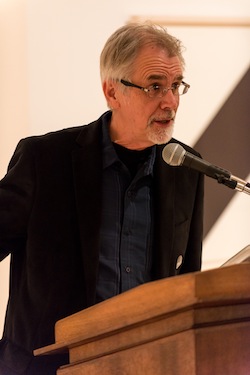Ghost Army
—for an exhibition of prints by Ellsworth Kelly (member of 23rd Headquarters Special Troops, 1943-44)
If art is a form of camouflage, subtle maneuvers
into the surfaces of the seen, these prints, for instance,
mostly abstract, beneath which lie certain impulses
embodied by technique, beneath which lies not
exactly an idea, more an old inclination
sprung from the itch of common mortality,
felt as if residing in each of us alone,
no wonder Kelly distilled the nature of things in frag-
mented bursts of color, line, surrounding space,
condensations of what’s too vast and blank to bear.
No wonder they drafted those art school students in 1943—
Ellsworth Kelly, Bill Blass, and the others—the Ghost Army,
they were called, to fabricate regiments of inflatable tanks,
fake cannons, rubber jeeps to outfox the Germans—Macy’s style
weaponry they paraded across France.
No wonder all the hours broadcasting babble and static,
apparitional advances, retreats, whimsical alarms
riding the monitored airwaves.
If we can occupy the enemy with killing what’s not
might a little more of what is survive?
Phantom platoons bobbing along the French hedgerows.
Decoy convoys floating towards the Rhine, seeming
to come from everywhere, or possibly nowhere?
It’s surprising the Germans never caught on, maybe
counter-attacked with their own imaginary forces, shelled
our synthetic soldiers with volleys of implied ordinance.
What if both sides began to just make up their weapons,
then started conjuring their motives as well
right down to the very notion of nation?
Why not fabricate not just the reason to die,
but the death itself?
If we pretend our slaughters on a broad enough scale,
and the others acquiesce, planting picturesque rows
of white crosses on graves filled with, I don’t know—
sawdust effigies, expertly shrouded bales of straw,
could the Ghost Army come back to save us still?
Might the fake offensive, the wily bombardments
of sound and fury allow the rest of us to just—
stay home? Could the next war wage itself
and the mock armies win or lose, for all we care?
Can we be sufficiently occupied by artifice?
Though most of the Ghost Army is gone, or near the brink
of their actual graves by now, I want to call them back
to launch a last offensive. I want the enemy, foreign
and domestic, inside my heart and head, and out,
to feign falling down in their numbers, in meadows,
in histrionic billows of gun smoke over the gullies.
I want long winded consecrations and eulogies,
torrents of theatrical grieving on all sides. I want
somber enough art to commemorate the dead
so poignantly
they need not even bother to die.
Let the shapes and colors of the ritual
hide us under the clamor, alive and kicking.
If all art is subterfuge, let the dark demands of the moment
be appeased by invention and show, while we pause,
mere flesh and bone, in the shelter of the ordinary,
on common streets, on winter nights, let’s say,
browsing the stores still open, milling about in museums
for the most frivolous of reasons. Look—
here’s a stroke of yellow, an abstract slant of green
to ponder, a red rhomboid, a spectral set of squares.
Here’s what appears to be cluster of oranges. And here
is a drawing of locust leaves—I remember those trees
from childhood—early summer, bees
swarming the flower studded branches,
how you could stand beneath the blossoms
and be filled with the humming yourself.
If the essence of an image is the motion inside,
the live orbital wonder of particle and wave
that holds each print precisely in place,
no wonder what moves in memory now
is the scent and hum of the locust trees, the smoke
with which we bewildered the bees and robbed
their hives of honey, how the sweetness
seemed more than itself, as if each drop
held the flowers and the thorns and the smoke
and even the seasons still to come.
Though sweetness is not quite word enough,
and time is not quite long enough to tell
how it truly tasted, melting into the tongue
and into the body and years until now. Look—
here are some pictures pinned to the wall, a wedge
of green, a cluster of oranges, a print of locust leaves.
Here is the milling about, the buzz and ghostly
echo of gallery talk, the sweet diversions
of ordinary evening, behind which looms not
exactly an idea, more an old inclination to linger
and look, let the senses bleed out into the bright
shared surfaces, while we pause, mere flesh and bone
deep in the mortal wonder, harbored in the artifice
of each of us alone.
—Max Garland


